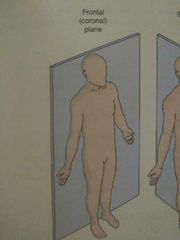![]()
![]()
![]()
Use LEFT and RIGHT arrow keys to navigate between flashcards;
Use UP and DOWN arrow keys to flip the card;
H to show hint;
A reads text to speech;
40 Cards in this Set
- Front
- Back
|
Anatomic position |
* standing erect * Arms at sides * Eyes and palms facing forward |
|
|
Supine |
Lying horizontal on the back, face up |
|
|
Prone |
Lying face down, in reference to the palms facing down |
|
|
Frontal (coronal) plane |

|
|
|
Sagittal plane |

|
|
|
Transverse (horizontal) plane |

|
|
|
Body directional terms * Superior (cranial) * Anterior (ventral) * Posterior (dorsal) * Interior (caudal) * Medial * Lateral |

|
|
|
Homeostasis |
A state of equilibrium or balance in the body's internal environment |
|
|
Body cavities |

|
|
|
Metabolism |
The sum of all physical and chemical reactions needed to sustain life |
|
|
Catabolism |
Complex substances are broken down, usually with release of energy (conversion or carbohydrates into glucose) |
|
|
Anabolism |
Simple substances are converted to more complex (synthesis of a hormone from substances in bloodstream) |
|
|
Cells |
Chromosomes: long strands of DNA organized into units called genes, occurring in humans in 23 identical pairs (46 individual)
Organelles: specialized structures within the cytoplasm
Surface organelles: structures within the cytoplasm
Flagellum: whip-like extension found on sperm |
|
|
Tissues |
Groups of similar cells that work together to perform a special function |
|
|
4 basic types of tissues |
Connective - supports and connects all parts of the body; includes adipose (fat), cartilage, bone, and blood Epithelial - covers and protects body and lines organs, vessels, and cavities Muscle - contracts to produce movement Nerve - transmits electrical impulses |
|
|
Skin layers |
Epidermis - outermost and thinnest layer Dermis - inner layer of skin Subcutaneous - connective and adipose tissue; connects to skin in surface muscles |
|
|
Epidermis |
* outermost and thinmest layer * Made up of stratified, squamous epithelial cells * Avascular (no blood or lymph vessels) * Only living cells are in deepest layer (stratum germinativum) * Nourished by diffusion of nutrients from dermis |
|
|
Dermis |
* inner layer of skin * Much thicker than epidermis * Composed of elastic and fibrous connective tissue * Contains blood and lymph vessels, sebaceous (oil) and sudoriferous (sweat) glands, and hair follicles * The dermis lies on on top of a layer of subcutaneous tissues |
|
|
Subcutaneous |
Connective and adipose tissue; connects skin to surface muscles |
|
|
Cardiac muscle |
Wall of heart; pumps blood out of heart 💓 |
|
|
Skeletal muscles |
Attached to bones; produces movement at joints |
|
|
Smooth muscle |
Wall of hollow organs; produces peristalsis |
|
|
Avascular |
No blood or lymph (fluid) vessels |
|
|
Bursa (joints) |
Sac filled with synovial fluid to ease kovement |
|
|
Skeletal system functions |
* is framework that gives body and shape and support * Protects internal organs * Provides movement and leverage (with muscular system) * Stores calcium * Produces blood cells in bone marrow (hemopoiesis) |
|
|
Nervous system functions |
* Controls and coordinates activities of various body systems by electrical impulses and chemical substances sent and received * Two functional divisions: Somatic - VOLUNTARY movement of skeletal muscle Autonomic - INVOLUNTARY movement of cardiac and smooth muscles and glands |
|
|
Somatic |
VOLUNTARY movement of skeletal muscle |
|
|
Autonomic |
INVOLUNTARY movement of cardiac and smooth muscles and glands |
|
|
Neuron |
* Fundamental unit of nervous system * Consists of cell body with nucleus and organelles, dendrites, and axons |
|
|
CNS |
Central Nervous System |
|
|
CNS Central Nervous System |
* brain and spinal cord * Surrounded and cushioned by a cavity filled with cerebrospinal fluid * Protected by 3 layers of connective tissue (meninges) |
|
|
Peripheral nervous system |
* Motor or efferent nerves - carry impulses from CNS to organs, glands, and muscles
* Sensory or afferent nerves - carry impulses to CNS from sensory receptors in various parts of the body |
|
|
Motor or efferent nerves |
Carry impulses from CNS to organs, glands, and muscles |
|
|
Sensory or afferent nerves |
Carry impulses to CNS from sensory receptors in various parts of the body |
|
|
Endocrine system functions |
* secretes hormones into bloodstream * Affects metabolism, growth, and development, reproduction, personality, response to stress, and resistance to disease |
|
|
Digestive system functions |
* takes in food * Breaks food down into usable components for absorption * Eliminates waste products |
|
|
Reproductive system functions |
* produces gametes needed to form a new human being - spermatozoa (males) - ova (females) |
|
|
Urinary system functions |
* filters waste products from the blood * Creates urine * Eliminates waste from body in urine * Helps regulate body fluids |
|
|
Respiratory system functions |
Respiration: * External - oxygen from air enters bloodstream in lungs and carbon dioxide leaves bloodstream and enters air from lungs * Internal - oxygen leaves bloodstream and enter cells in tissues and carbon dioxide from cells enter bloodstream |
|
|
Adipose |
Fat |

